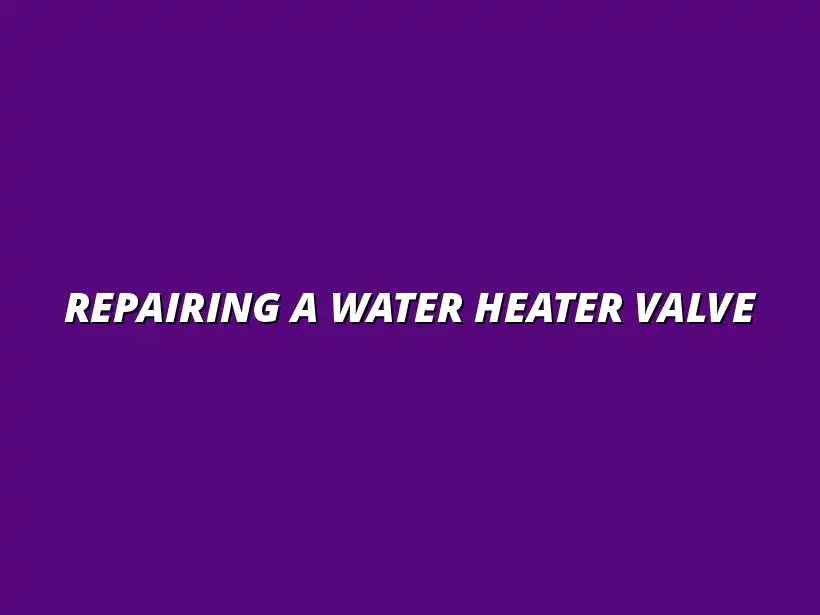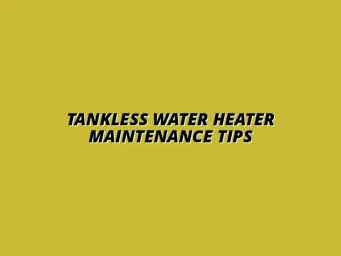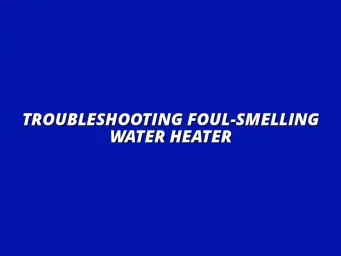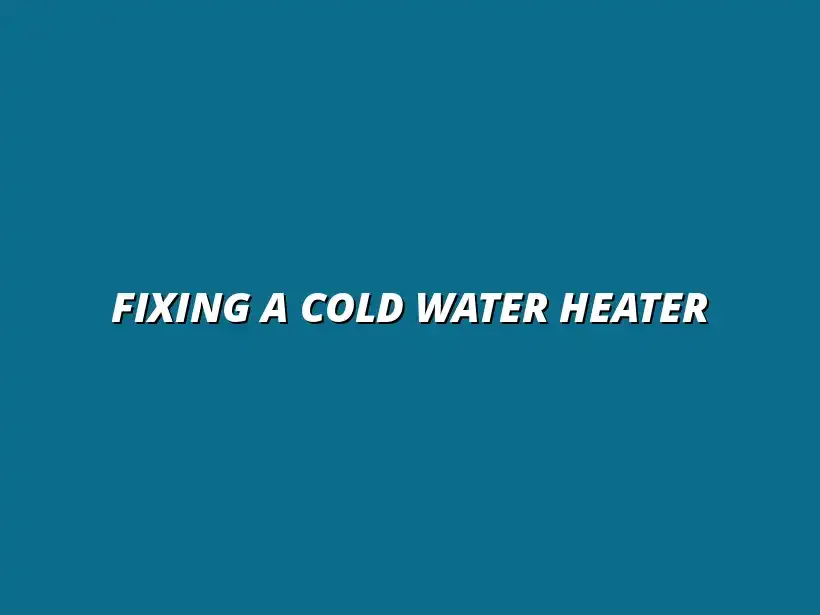
Repairing a Water Heater Valve
Understanding the Importance of the Water Heater Pressure Relief Valve
The pressure relief valve is a crucial safety feature in any water heater. It functions to release excess pressure that can build up inside the tank, helping to prevent dangerous explosions. Understanding its role is essential for maintaining a safe and efficient home environment.
When water is heated, it expands, increasing the pressure within the tank. The pressure relief valve acts like a safety net, automatically releasing water when the pressure exceeds safe levels. This simple mechanism can save you from costly damage and ensure your household remains safe!
What is a Pressure Relief Valve and Its Role in Water Heaters?
A pressure relief valve is a critical component of your water heater that manages pressure levels. It is designed to open at a predetermined threshold, allowing water to escape when the pressure becomes too high. This prevents potential hazards like bursting tanks or scalding water leaks.
By maintaining safe pressure levels, the valve protects not only the water heater but also your home. If you think about it, it’s like having a superhero watching over your hot water system! For more information on maintaining your water heater efficiently, check out these maintenance tips.
- Automatically releases excess pressure.
- Prevents tank explosions.
- Ensures safe water temperatures.
Common Issues Associated with Broken Pressure Relief Valves
When a pressure relief valve malfunctions, it can lead to several problems. One of the most common issues is leakage, where water seeps out of the valve continuously. This not only wastes water but can also lead to damage around the water heater. Learning how to repair a leaking water heater pipe is a valuable skill.
Another issue is that the valve may become stuck, failing to open when needed. This can trap excessive pressure inside the tank, creating a dangerous situation.
- Leakage of hot water.
- Stuck valve preventing pressure release.
- Corrosion and mineral buildup affecting performance.
Signs Indicating a Faulty Pressure Relief Valve
Recognizing signs of a faulty pressure relief valve is essential for early intervention. Some common indicators include:
- Water pooling around the valve.
- Strange noises from the water heater.
- Frequent fluctuation of water temperature.
If you notice any of these signs, it's crucial to act quickly before the situation worsens. Ignoring these warnings could lead to more severe damage and costly repairs! Understanding common water heater issues can help prevent costly repairs.
Potential Risks of Ignoring Valve Issues
Ignoring a malfunctioning pressure relief valve can be risky. One of the most significant dangers is the possibility of tank explosions, which can cause serious injury and property damage. Additionally, you might face water damage due to leaks, leading to mold and structural problems.
Moreover, a broken valve can result in inefficient water heating, leading to higher energy bills. Addressing these issues promptly can save you a lot of money and ensure your home remains safe. Regular checks, as described in this guide on regular bathroom water heater checks, are essential.
Assessing the Condition of Your Water Heater Pressure Relief Valve
Regularly checking your water heater pressure relief valve is essential for maintaining its functionality. By assessing its condition, you can identify potential problems before they escalate. This proactive approach helps minimize repairs and ensures safety.
In the next sections, we’ll go through the steps involved in inspecting your pressure relief valve effectively. Let’s take a closer look at how to keep your water heater running smoothly!
Maintenance Tips for Preventing Future Valve Breakdowns
Keeping your water heater's pressure relief valve in good working order is crucial for safety and efficiency. Regular maintenance can help avoid unexpected breakdowns and costly repairs. By following a few simple practices, you can extend the life of your valve and ensure your water heater operates smoothly.
One of the best ways to maintain your valve is through regular inspection. This means setting aside time to check the valve and the entire water heater system. Keeping an eye on things can alert you to any issues before they become serious problems. Regular flushing, as detailed in our guide on how to flush your water heater easily, is also crucial.
Regular Inspection and Maintenance Practices
Implementing a consistent routine for inspecting your pressure relief valve can save you from future headaches. Here are some effective practices to incorporate into your maintenance routine:
- Check the valve at least once a month.
- Flush the water heater every six months to remove sediment.
- Inspect all connections and fittings for signs of wear or corrosion.
By sticking to a regular maintenance schedule, you can keep your water heater running efficiently. Remember, a little effort on your part can prevent major repairs down the line!
Creating a Schedule for Routine Checks
Having a schedule for your maintenance checks is important. You can create a calendar with reminders, or use a phone app to keep track of your inspections. Aim for a mix of monthly and biannual checks for the best results.
Here’s a simple schedule to follow:
- Monthly: Inspect the pressure relief valve and connections.
- Every 6 months: Flush the tank and check for sediment buildup.
- Yearly: Have a professional inspection to ensure everything is in top shape.
Best Practices for Maintaining Water Heater Efficiency
To maintain a high level of efficiency, consider some of these best practices:
- Keep the water heater temperature set between 120°F and 140°F.
- Insulate your pipes and tank to keep heat from escaping.
- Consider a tankless water heater for on-demand hot water.
Following these practices not only improves efficiency but also reduces energy costs. Regular maintenance will keep your heating system in top shape! For help with plumbing issues in Birmingham, consider contacting a plumber in Billesley, Birmingham.
Understanding When to Replace Your Water Heater
Sometimes, despite your best efforts, a water heater just needs to be replaced. Knowing when to take this step can save you time and money. It’s essential to evaluate signs that indicate it’s time for a new installation.
Here are some common indicators for a new water heater:
- Age of the water heater: Over 10-15 years old.
- Frequent repairs becoming necessary.
- Inconsistent hot water supply.
- Visible leaks or rust around the tank.
If you're seeing these signs, it might be best to start researching new models. A reliable water heater will save you from disruptions in hot water supply!
Indicators for a New Water Heater Installation
Aside from the age and repairs, other factors can hint that it’s time to replace your water heater:
- Higher energy bills than usual, indicating inefficiency.
- Strange noises coming from the tank.
- Water discoloration or foul smells.
Paying attention to these signs can help you make a timely decision, ensuring you don’t face unexpected cold showers!
Evaluating Cost-Effectiveness of Repairs vs. Replacement
When weighing the options between repairs and replacement, consider the following:
- Cost of repairs versus a new unit.
- Expected lifespan after repairs.
- Energy efficiency and savings from a new model.
Conducting this evaluation will help you make an informed choice about the best route for your home's hot water needs!
Frequently Asked Questions About Pressure Relief Valve Repairs
What Causes Pressure Relief Valves to Fail?
Pressure relief valves can fail for a variety of reasons. Sometimes it's due to sediment buildup, while other times, it may be simply because the valve is old. Regular maintenance can help you catch these issues early!
How Often Should I Inspect My Pressure Relief Valve?
I recommend inspecting your pressure relief valve at least once a month. However, if you notice any signs of trouble, it’s best to check it immediately. Consistent monitoring is the key to preventing bigger problems!
Can I Repair a Valve That Is Leaking?
If your valve is leaking, it might be repairable, but it's often a sign that it needs replacing. Trying to fix it without proper knowledge can lead to further issues. Always evaluate your options carefully!
What Are the Risks of a Broken Pressure Relief Valve?
A broken pressure relief valve can lead to dangerous situations, including water heater explosions. Ignoring a faulty valve puts you and your home at risk. It's best to address issues promptly to ensure safety! Remember, proper drainage is also important for overall home health.
Final Thoughts on Maintaining a Safe and Efficient Water Heater System
Keeping your water heater in good shape is vital for both safety and efficiency. Regular inspections, maintenance, and timely replacements can make a big difference. By being proactive, you can avoid costly repairs and enjoy a consistent hot water supply!
Encouraging safe practices and timely repairs will help ensure that your water heater remains reliable. Always remember that the effort you put into maintenance pays off in the long run!




